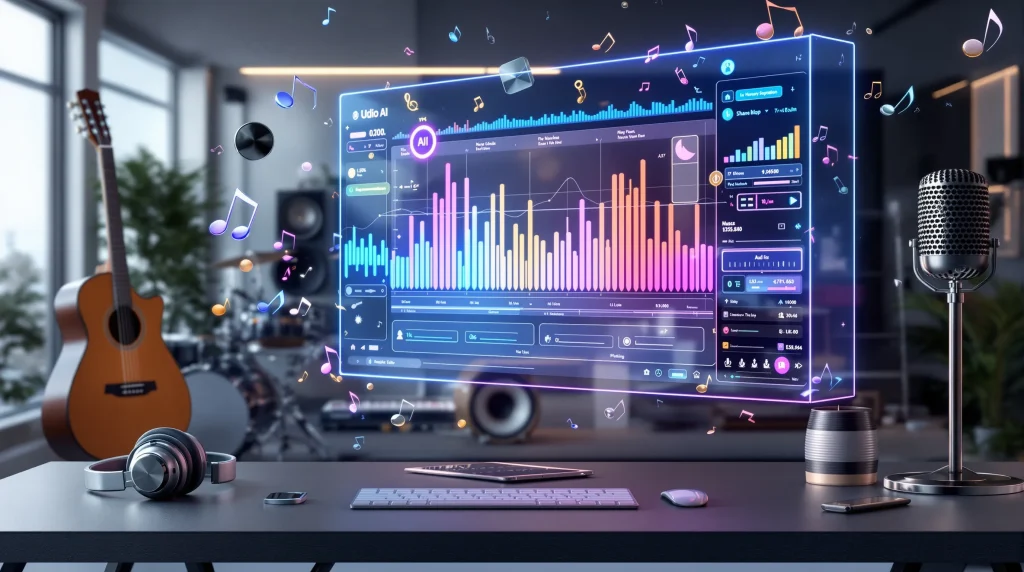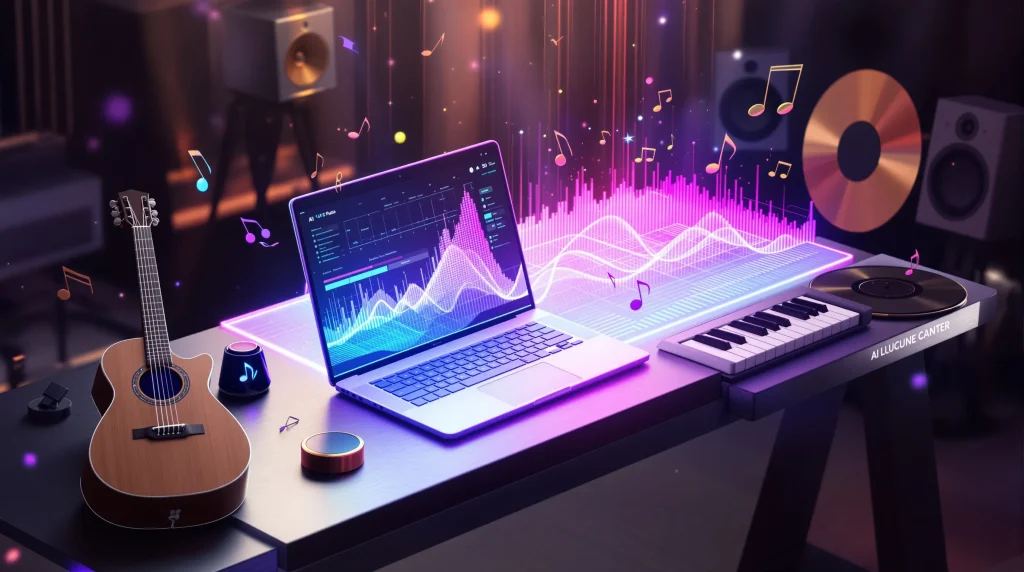私はしばらくAIツールを探求してきたが、Suno AIがもたらしてくれるものについては、全く準備ができていなかった。これは単なる音楽ジェネレーターではなく、音楽制作についての考え方を根本から変えるプラットフォームなのだ。シンプルなテキストプロンプトから生成されたトラックを初めて聴いたとき、私は純粋に感動した。クオリティ、感情、構成、すべてが驚くほど本物だと感じた。あなたがBGMのために奔走しているコンテンツ制作者であれ、新しいサウンドを試しているミュージシャンであれ、あるいはAIに何ができるのかに興味がある人であれ、Suno AIはジェネレーティブ・テクノロジーにおける魅力的な飛躍を象徴している。この文章では、このプラットフォームがどのように機能するのかから、誰が使うのが一番得なのかに至るまで、私がこのプラットフォームについて学んだことをすべて紹介する。.
Suno AIとは?
スノーAI は、人工知能を搭載した音楽生成プラットフォームで、テキスト記述から完全なオリジナル楽曲を作成する。マサチューセッツ州ケンブリッジの音楽家とAI研究者のチームによって立ち上げられ、音楽の訓練や技術的な専門知識に関係なく、誰でもプロ品質の音楽にアクセスできるように設計されている。.
Sunoが私がテストした他のAI音楽ツールと違うのは、その包括性だ。楽器のループや基本的なメロディーを得るだけではない。このプラットフォームは、ボーカル、ハーモニー、インストゥルメンテーション、適切な曲構成の完全なトラックを生成する。夏の冒険についてのアップビートなインディー・ロック・ソング」などと入力すると、数分以内に完全に制作されたトラックを受け取ることができる。.
Suno AIの背後にあるテクノロジーは、膨大な音楽データに基づいて訓練された高度な機械学習モデルに根ざしている。しかし、単に既存のサウンドをリミックスするツールとは異なり、Sunoはゼロからオリジナルの楽曲を生成する。これは、すべてのトラックがユニークであることを意味し、所有権に関する重要なニュアンスは後述するが、既存のレコーディングの著作権問題を心配する必要はない。.
公開以来、Sunoはカスタムミュージックを素早く必要とするクリエイターの間でかなりの支持を得ている。YouTubeの動画、ポッドキャスト、インディーズゲームのサウンドトラック、さらには結婚式の歌のような個人的なプロジェクトにも使われているのを見た。このプラットフォームは、プロンプトの文脈や感情を理解する能力があるため、初めてのユーザーでも驚くほど直感的に操作できる。.
Suno AIの仕組み
テキストを音楽に変換する技術
Suno AIの核心は、DALL-EやMidjourneyのようなイメージジェネレーターがどのように機能するかに似たコンセプトのテキストから音楽へのモデルを使用している。あなたが欲しいものを説明するテキストプロンプトを提供すると、AIはその説明を解釈して対応するオーディオを生成する。しかし、音楽は静的なイメージよりもはるかに複雑で、時間をかけて展開し、ハーモニーの一貫性、リズム構造、感情的な進行を必要とする。.
このモデルは、ジャンル、ムード、テンポ、楽器編成、ヴォーカル・スタイルといった重要な要素を特定することで、プロンプトを処理する。ピアノとサックスによるメランコリックなジャズバラード」と入力すると、システムは各要素を解析し、生成の青写真を構築する。そしてニューラルネットワークは、音楽的な一貫性を保ちながら、これらのパラメーターに沿ったオーディオを生成する。.
私が最も感銘を受けたのは、Sunoが抽象的なコンセプトをうまく扱っていることだ。雨の降る夜の街をドライブしている感じ」というようなプロンプトで実験したところ、その雰囲気を純粋に捉えたトラックが送られてきた。AIは単にキーワードをマッピングするだけでなく、感情や物語の文脈を解釈する。.
ジェネレーション・プロセス
私がSuno AIを使う場合、そのプロセスは驚くほど簡単だ。ログインすると、シンプルなインターフェースが表示され、テキストプロンプトで希望の曲を説明するか、カスタム歌詞を入力することができる。このプラットフォームには主に2つのモードがある:シンプル・モード(欲しいものを記述するだけ)とカスタム・モード(歌詞、スタイルタグ、タイトルを指定できる)だ。.
私がプロンプトを送信すると、Sunoは通常30秒から90秒以内に2つの曲のバリエーションを生成する。これにより、私はその中から選んだり、反復したりするオプションを得ることができる。必要に応じてトラックを延長したり、セグメントを追加することもできる。.
音質は驚くほど高く、トラックはほとんどのコンテンツ用途に適したフォーマットで配信される。AIはトランジション、ヴァースとコーラスの構成、そしてブリッジさえも有能に処理することに気づいた。結果には改良が必要なこともあるが、初期世代はすぐに使えることが多い。.
特筆すべき点として、プロセスが速い一方で、思い描いたものを正確に実現するには数回の反復が必要になることがある。どんなAIツールでもそうだが、プロンプト・エンジニアリングは重要だ。ジャンル、ムード、インストゥルメントを具体的に説明することで、曖昧な説明よりも良い結果が得られることが一般的だ。.
Suno AIの主な特徴
プロ仕様のオーディオ品質
Suno AIを初めてテストしたとき、私は明らかなアーチファクトを伴うロボット音のオーディオを期待していた。その代わり、多くのインディーズリリースに匹敵する制作品質で迎えられた。このプラットフォームは、楽器間の明確なセパレーション、バランスの取れたミキシング、最小限の歪みで、忠実度の高いトラックを生成する。.
特にボーカルが際立っている。シンセサイザーでありながら、感情的で自然なフレージングで、すぐに “AIが作った ”とは感じさせない。複数のボーカルレイヤー、ハーモニー、そしてリバーブやディレイのようなボーカルエフェクトがセンス良く適用されたトラックも聞いたことがある。ボーカリストを雇う必要のないナレーションや歌唱を必要とするコンテンツ制作者にとって、この機能は非常に貴重だ。.
とはいえ、世代によっては、特にAIが時折まとまりを失うような長いトラックでは、まだ不気味なクオリティがある。しかし、ほとんどの用途、特にBGMやデモ・トラックには十分すぎるクオリティだ。.
ジャンルの多様性とカスタマイズ
Suno AIは、音楽スタイルを1つか2つに限定しません。私は、クラシックのオーケストラ曲からヘビーメタル、ローファイ・ヒップホップ、カントリー・バラード、エレクトロニック・ダンス・ミュージック、さらには実験的なアンビエント・サウンドスケープまで、あらゆる音楽の生成に成功した。その幅の広さには本当に感心させられる。.
カスタマイズはジャンル選択にとどまらない。テンポ(「速いテンポ」または「ゆっくり瞑想的」)、楽器編成(「アコースティックギターとバイオリン」)、ムード(「ノスタルジック」、「エネルギッシュ」、「ダーク」)、さらには時代特有のスタイル(「80年代シンセウェーブ」または「90年代グランジ」)まで指定できる。私のプロンプトが詳細であればあるほど、アウトプットはよりカスタマイズされる。.
また、リファレンス・トラックをアップロードしたり、前の世代から続けてアップロードすることで、複数の曲でスタイルの一貫性を保つことができる機能もある。これは、アルバムやプロジェクト用のまとまった曲集を作るときに特に便利だ。.
歌詞とヴォーカル・ジェネレーション
Suno AIの際立った能力のひとつは、歌詞とボーカルの両方を生成する能力だ。私自身が歌詞を提供することも、私が指定したテーマに基づいてAIに書かせることも、完全に即興で作らせることもできる。私がカスタム歌詞を入力すると、Sunoはそれを詩、コーラス、ブリッジにアレンジし、適切なメロディ構造を適用する。.
ボーカルの生成には、男性、女性、さまざまな音色のボイスタイプがある。AIはジャンルに合わせてヴォーカルを変化させる。ロックでは荒々しくアグレッシブに、R&Bではスムーズでソウルフルに、ポップスでは遊び心とリズミカルに。細かいコントロールで特定の声の特徴を選択することはできないが、デフォルトは概してスタイルによくマッチしている。.
歌詞の質はさまざまだ。時には純粋に賢く、首尾一貫した詩を得ることもある。また、歌詞が一般的でなかったり、少しずれていたりすることもある。本格的な曲作りには、自分で言葉を用意することをお勧めする。しかし、プレースホルダーのコンテンツや実験には、AIが生成した歌詞が驚くほどよく機能する。.
料金プランとアクセシビリティ
Suno AIは、さまざまなユーザーのニーズに対応するために、段階的な価格体系を提供しています。私は、新規ユーザーが金銭的なコミットメントなしにプラットフォームをテストできる無料階層が用意されていることを高く評価している。無料プランには、1日あたりの生成クレジット数が制限されており、通常は1ヶ月に約10曲を作成するのに十分な数となっている。.
より本格的なユーザーには、Proプラン(本稿執筆時点で月額$10程度)が世代数の上限を大幅に増やし、毎月およそ500クレジットを提供する。これは約500曲分に相当し、ほとんどのコンテンツ・クリエイターやホビイストにとっては十分すぎる量だ。また、プロ契約者は優先的な生成速度と、作成した楽曲の商用利用権を得ることができる。.
Premierプランは、より高い価格(月額約$30)で、パワーユーザー、大規模な音楽制作やプロフェッショナルな商業プロジェクト向けのプランです。より多くのクレジット、より高速な処理、ピーク時のキューをバイパスする機能が含まれます。.
アクセシビリティに関する重要な注意点:インターフェイスはユーザーフレンドリーでウェブベース(ソフトウェアのインストールは不要)だが、著作権と使用権は複雑な場合がある。無料ティアのユーザーは自動的に商業的権利を取得するわけではないので、Sunoが生成した音楽を使ったコンテンツを収益化しようと考えているのであれば、少なくともProティアにアップグレードすることが不可欠だ。AIが生成したコンテンツの所有権はまだ発展途上の法的状況であるため、利用規約を常に注意深く読むことをお勧めする。.
誰がSuno AIを使うべきか?
コンテンツ制作者とソーシャルメディア・ユーザー
もしあなたがYouTuber、ポッドキャスター、TikTokクリエイター、Instagramインフルエンサーなら、Suno AIはゲームチェンジャーになり得る。楽曲のライセンス取得や著作権侵害への対応に煩わされることなく、動画の雰囲気にぴったり合ったBGMを生成するのに特に便利だと感じている。カスタムのイントロやアウトロの音楽、モンタージュ用のサウンドトラック、ナレーション用のアンビエント・トラックなど、コンテンツの雰囲気に合わせて作ることができる。.
ソーシャルメディアのクリエイターは、特にスピードの恩恵を受けます。毎日コンテンツを制作していると、依頼された音楽を待つのは現実的ではありません。Sunoを使えば、2分以内に適切なトラックを作成し、編集に移ることができます。さらに、各トラックの独自性は、あなたのコンテンツが他の人と同じに聞こえないことを意味します。.
ミュージシャンとプロデューサー
音楽制作に携わる者として、私は当初、Suno AIが脅威と感じるのか、それともツールと感じるのか疑問に思っていた。広範囲に使用した後、私は後者、ブレーンストーミング、デモ、創造的なブロックを克服するための強力な支援として見ています。.
ミュージシャンは、Sunoを使って曲のアイデアを素早くスケッチすることができる。メロディーやコンセプトはあるけれど、フルデモを録音する時間やリソースがない場合、Sunoでラフバージョンを作り、後で生楽器やボーカルを使って洗練させることができる。また、自分が心地よいと感じるジャンルの外を探ったり、型にはまらないアレンジを試したりするのにも最適だ。.
プロデューサーは、Sunoがリファレンス・トラックの作成やリミックス用のステムの生成、あるいは締め切りの厳しいクライアントのBGM制作に役立つと思うかもしれない。熟練した人間のミュージシャンのニュアンスに取って代わることはできないが、クリエイティブなツールキットに加える価値あるものだ。.
企業およびマーケティング担当者
企業はコマーシャル、プロモーションビデオ、プレゼンテーション、ブランデッドコンテンツに音楽を必要としています。従来は、ストック音楽のライセンスを購入するか、カスタム作曲を依頼するかのどちらかでしたが、どちらも高価で時間がかかります。.
Suno AIは、費用対効果の高い代替案を提供します。私は、マーケティング担当者がオンブランドのジングルや説明ビデオのサウンドトラック、さらにはカスタマーサービス用の保留音楽を作成するためにSuno AIを使用しているのを見てきました。ムードやスタイルを指定できるため、長いクリエイティブ・ブリーフや修正サイクルを経ることなく、ブランド・アイデンティティに沿った音楽を作ることができます。.
限られた予算で運営されている中小企業や新興企業にとって、Sunoは、そうでなければ手の届かなかったプロフェッショナルなサウンドの音楽へのアクセスを民主化します。.
利点と限界
プラットフォームの強み
Suno AIの最大の強みはアクセシビリティです。音楽理論の知識も、高価なDAWも、聴きやすい音楽を作るための技術的スキルも必要ない。参入障壁が実質的に存在しないため、まったく新しいクリエイターに力を与えることができる。.
スピードも大きな利点だ。作曲からミキシング、マスタリングまで、従来の音楽制作には数時間から数日かかります。Sunoは数秒で結果を出します。締め切りの厳しいプロジェクトでは、この効率性は非常に貴重です。.
また、創造的なインスピレーションを与えてくれることにも感謝している。行き詰まったときや新鮮なアイデアを探しているときに、ランダムにトラックをいくつか作ると、思いがけない方向性が閃くことがある。それは、あなたの奔放な実験を決して批判しない、限りなく忍耐強い協力者がいるようなものだ。.
バラエティとカスタマイズのオプションも印象的だ。直感的なインターフェイスに包まれたSunoのようなジャンルの広さとスタイルのコントロールを提供するプラットフォームはほとんどない。.
現在の制限
長所があるとはいえ、スノのAIは完璧ではない。私が一貫して遭遇してきた限界のひとつは、きめ細かなコントロールができないことだ。例えば、正確なコード進行を指定したり、個々の楽器の音量を調整したり、正確なアレンジの選択を指示したりすることはできない。AIの解釈に翻弄されてしまうのだ。.
長い曲は時に一貫性を失う。曲の長さが3、4分を超えると、スタイルが流れたり、繰り返しになったりすることがある。AIは長時間に渡ってテーマの一貫性を保つのに苦労している。.
ヴォーカルの質は印象的ではあるが、完璧ではない。発音がおかしく感じられたり、言い回しがぎこちなかったり、感情的な表現が歌詞とまったく合っていなかったりする瞬間がある。プロ向けのリリースでは、AIボーカルを人間のパフォーマンスに置き換えた方がいいだろう。.
最後に、倫理的・法的なグレーゾーンがある。学習データ、著作権、そしてAIが生成する音楽が人間の芸術性を軽んじるかどうかについての疑問は、依然として論争の的となっている。テクノロジーと伝統的な職人技の両方を重視する者として、私はこれらの懸念が妥当であり、現在進行中であると認識している。.
AIが音楽制作に与える影響
Suno AIは、クリエイティブ産業を再構築するジェネレーティブAIツールの大きな波の一部である。その意味は深く、多面的である。一方では、Sunoのようなプラットフォームは音楽制作を民主化し、これまで自分のトラックを制作する手段やトレーニングを持っていなかった人々に声を与える。この包括性は純粋にエキサイティングだ。.
しかし、音楽界には不安もある。AIはセッション・ミュージシャンや作曲家、プロデューサーに取って代わるのだろうか?全面的に取って代わられるとは思わないが、特定の役割、特に商業音楽とBGMの役割は変化するかもしれない。ストックミュージックライブラリー、ジングルの作曲家、BGMのプロデューサーは、混乱に直面するかもしれない。.
私が最も興味深いと思うのは、AIが創造性そのものを再定義するかもしれないということだ。人間のミュージシャンに取って代わるのではなく、Sunoのようなツールがコラボレーターとなり、可能性を広げ、ワークフローを加速させるかもしれない。かつてドラムマシンやシンセサイザーが物議を醸したが、やがて標準的なツールになったように、AI音楽ジェネレーターもクリエイティブなエコシステムの中で居場所を見つけるかもしれない。.
もし機械が私たちの感情を揺さぶる音楽を生み出せるとしたら、それは芸術について何を語っているのだろうか?私は、音楽の力は創作だけでなく、その受容にあることを浮き彫りにしていると思う。人間の手によるものであれ、アルゴリズムによるものであれ、リスナーの心に響く曲には価値がある。.
それでも私は、不完全さ、意図性、生きた経験を持つ人間の音楽性は、AIには完全には再現できないものを提供してくれると信じている。テクノロジーによって代替されるのではなく、補強され、SunoのAIが、より多くの人々が音楽づくりの喜びに参加するためのツールとなることが、最善の道なのかもしれない。.
結論
Suno AIは、人工知能と音楽テクノロジーにおける目覚ましい成果だ。Sunoを幅広く使用した経験から、音楽制作を身近に、迅速に、そして驚くほど高品質にするという約束を果たしていると言える。カスタム・サウンドトラックを必要とするコンテンツ制作者、新しいアイデアを探求するミュージシャン、費用対効果の高いオーディオ・ソリューションを探しているビジネスなど、Sunoは本物の価値を提供します。.
とはいえ、魔法の弾丸ではない。このプラットフォームは、コントロール、長いトラックでの一貫性、プロの人間のミュージシャンがもたらすニュアンスの質において限界がある。パワフルで革新的なツールではあるが、人間の創造性とともに思慮深く使用することで、最高の効果を発揮するツールであることに変わりはない。.
AIが進化し続ける中、スノのようなプラットフォームがどのように発展していくのか楽しみだ。よりきめ細かいコントロールが可能になるのか?ロングフォームのまとまりが良くなる?声のリアリズムの向上?この3つの答えはすべてイエスだろう。今のところ、Suno AIは最も印象的で実用的な音楽生成ツールのひとつである。音楽制作の未来はここにあり、かつてないほど身近なものとなっている。.
よくある質問
Suno AIとは何ですか?
Suno AIは人工知能を搭載している。 音楽制作プラットフォーム, テキストの説明からオリジナル曲を作成します。高度な機械学習モデルを使って、ジャンル、ムード、テンポ、インストゥルメンテーションなどのプロンプトを解釈し、ボーカル、ハーモニー、適切な曲構成を持つユニークなトラックを30秒から90秒以内に生成します。.
Suno AIの音楽は商用利用できますか?
商用利用権はサブスクリプション・ティアによって異なります。フリー・ティアのユーザーは自動的に商業利用権を取得しませんが、プロ・プランのサブスクライバー(月額約$10)は、作成した楽曲の商業利用権を取得します。Suno AIが生成した楽曲を使用したコンテンツを収益化する予定がある場合は、少なくともPro階層へのアップグレードが不可欠です。.
Suno AIの価格は?
Suno AIは3つの階層を提供している:毎日のクレジットに制限のある無料プラン(毎月約10曲)、約$10/月のProプラン(毎月約500曲、商業的権利付き)、そして、より大容量と高速処理を必要とするパワーユーザー向けの約$30/月のプレミアプラン(優先キューへのアクセス権付き)。.
Suno AIは他のAI音楽ジェネレーターより優れていますか?
Suno AIは、ループやメロディーだけでなく、ボーカル、ハーモニー、完全なインストゥルメントを含む完全なトラックを生成する点で際立っています。印象的なジャンルの多様性、プロ級の音質、感情的な文脈を解釈する直感的なテキスト・トゥ・ミュージック・テクノロジーを提供する。しかし、従来の音楽制作ソフトウェアと比べると、きめ細かなコントロールには限界がある。.
Suno AIはどのようなジャンルを作ることができますか?
Suno AIは、クラシック・オーケストラ、ヘビーメタル、ローファイ・ヒップホップ、カントリー、エレクトロニック・ダンス・ミュージック、ジャズ、ロック、R&B、ポップス、シンセウェーブ、グランジ、エクスペリメンタル・アンビエントなど、ほぼあらゆるジャンルの音楽を生成できます。テンポ、インストゥルメンテーション、ムード、時代特有のスタイルまで指定して、トラックをカスタマイズできます。.
AI音楽ジェネレーターは人間のミュージシャンに取って代わるのか?
Suno AIのようなAIツールは、特定の商業音楽やBGMの役割を破壊するかもしれないが、人間のミュージシャンに完全に取って代わることはないだろう。AIには今のところ、人間の音楽家が提供するようなニュアンスに富んだ意図性や生きた経験が欠けている。むしろ、これらのプラットフォームは、音楽創作を民主化し、人間の創造性を補強するコラボレーション・ツールとして捉えた方がいいだろう。.



